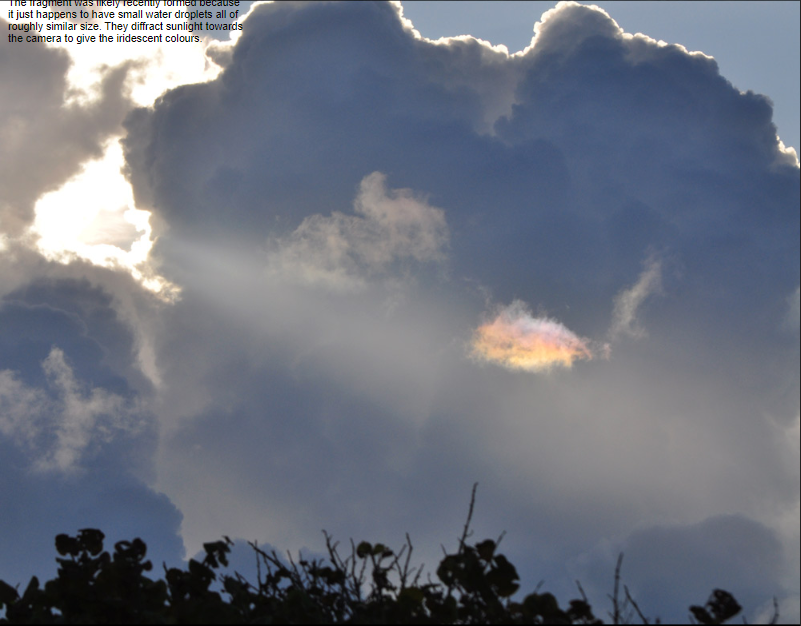Fractus Iridescence
Fractus Iridescence: A Transient Optical Phenomenon
Have you ever witnessed a fleeting moment of enchanting colors in the sky? These captivating displays, known as fractus iridescence, are a type of optical effect that can leave us in awe. In this article, we will delve into the fascinating world of fractus iridescence and explore the science behind this transient phenomenon.
Fractus iridescence occurs when sunlight interacts with small water droplets within a lower-level cloud fragment. These droplets are typically of similar size, indicating that the cloud fragment was recently formed. As sunlight passes through these tiny droplets, it undergoes diffraction, causing the light to spread out and create a stunning display of iridescent colors.
The iridescent colors observed in fractus iridescence are the result of interference and diffraction of light. When light waves interact with each other, they can either reinforce or cancel each other out, leading to variations in color intensity. The intricate interplay between the diffracted light waves gives rise to the shimmering hues that dance across the cloud fragment.
One of the key factors contributing to the formation of fractus iridescence is the presence of a gap in the towering cumulus clouds. This gap allows a ray of sunlight to penetrate through and illuminate the lower-level cloud fragment, creating the perfect conditions for iridescence to occur. The timing and positioning of the sunlight, along with the alignment of the water droplets, all play a role in determining the intensity and extent of the iridescent colors.
Fractus iridescence is a transient phenomenon, meaning it is short-lived and can vanish as quickly as it appears. These ethereal displays often last only for a few moments or minutes before dissipating. The ever-changing nature of atmospheric conditions contributes to the ephemeral nature of fractus iridescence, making it a rare and captivating sight to behold.
While fractus iridescence is most commonly observed in lower-level cloud fragments, it can also occur in other atmospheric phenomena, such as cirrus clouds or even ice crystals. The presence of uniform-sized particles or droplets is crucial for the diffraction and interference of light waves to create the iridescent effect. Therefore, the size distribution and composition of the particles within the cloud play a significant role in determining whether fractus iridescence will occur.
Photographing fractus iridescence can be a challenging task due to its transient nature. However, skilled photographers have managed to capture these mesmerizing displays, allowing us to marvel at their beauty long after they have faded from the sky. Sam Reynolds, a talented photographer, captured stunning images of fractus iridescence at the East End of Grand Cayman Island, showcasing the vivid colors and delicate patterns created by this optical phenomenon.
In conclusion, fractus iridescence is a captivating and transient optical phenomenon that occurs when sunlight interacts with small water droplets within a lower-level cloud fragment. The diffraction and interference of light waves give rise to the shimmering iridescent colors that grace the sky for fleeting moments. Understanding the science behind fractus iridescence enhances our appreciation for the wonders of the natural world and reminds us of the beauty that can be found in even the most fleeting moments.

Iridescent Fractus ~ Images by Sam Reynolds taken at the East End of Grand Cayman Island. �Sam Reynolds, shown with permission.
Optical effects can be very transient. Here a gap in the towering cumulus gives a ray of sunlight. It happens to shine on a lower level cloud fragment. The fragment was likely recently formed because it just happens to have small water droplets all of roughly similar size. They diffract sunlight towards the camera to give the iridescent colours.

Note: this article has been automatically converted from the old site and may not appear as intended. You can find the original article here.
Reference Atmospheric Optics
If you use any of the definitions, information, or data presented on Atmospheric Optics, please copy the link or reference below to properly credit us as the reference source. Thank you!
-
<a href="https://atoptics.co.uk/blog/fractus-iridescence/">Fractus Iridescence</a>
-
"Fractus Iridescence". Atmospheric Optics. Accessed on April 18, 2024. https://atoptics.co.uk/blog/fractus-iridescence/.
-
"Fractus Iridescence". Atmospheric Optics, https://atoptics.co.uk/blog/fractus-iridescence/. Accessed 18 April, 2024
-
Fractus Iridescence. Atmospheric Optics. Retrieved from https://atoptics.co.uk/blog/fractus-iridescence/.